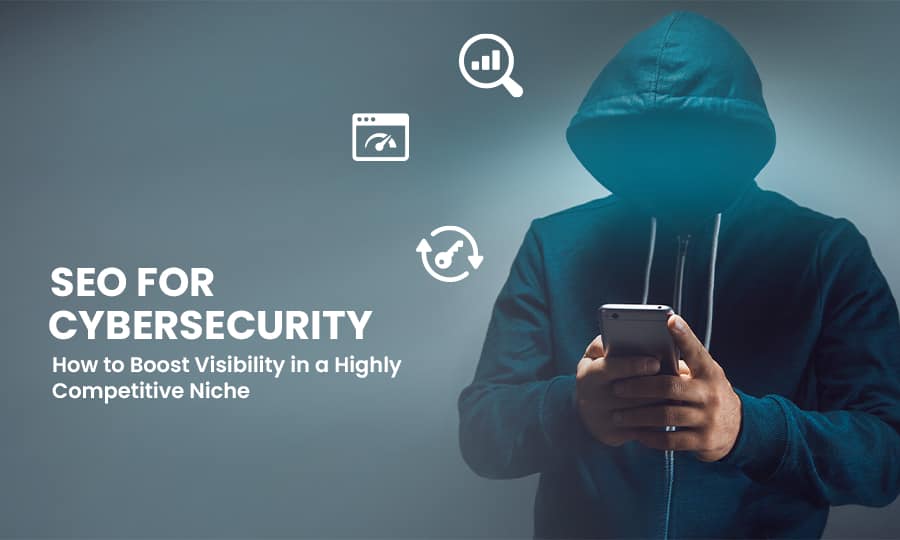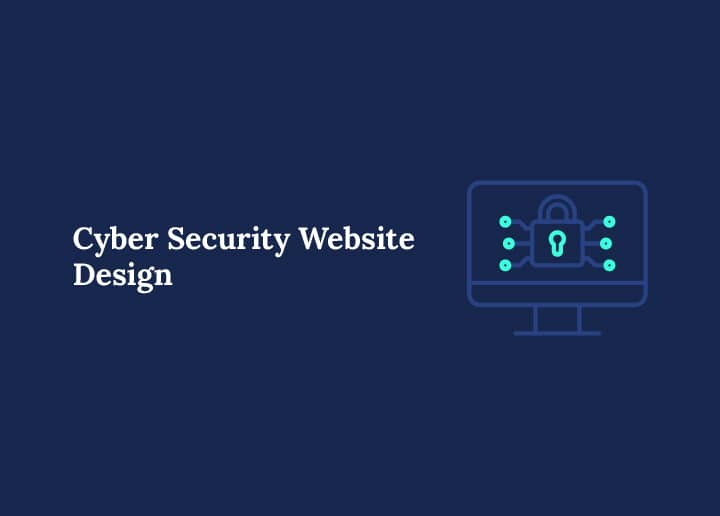With cybercrime expected to cost the world $10.5 trillion annually by 2025, cybersecurity businesses can’t afford to have websites that look outdated, generic, or worse—untrustworthy. A cyber security website is more than a digital business card—it’s the front line of your brand’s credibility, professionalism, and technical authority.
In a space where trust is currency, your website must instantly convey that you know how to protect sensitive data and defend against threats. This guide will help you master cyber security website design with proven strategies, real-world examples, and tips to turn your website into a powerful lead-generation engine.
Key Principles of High-Performing Cyber Security Website Design

Creating a compelling cyber security website isn’t just about showcasing your services—it’s about building immediate trust and ensuring a seamless user experience. Here’s what sets high-performing cyber security websites apart:
Visual Trust Signals (Secure Icons, SSL Badges, Verified Logos)
Security starts with perception. Visitors instantly judge your credibility by what they see within the first few seconds. SSL certificates, padlock icons, and security badges signal that your site is trustworthy. Displaying partner or compliance logos (e.g., ISO, GDPR, HIPAA) can further build trust with enterprise clients and decision-makers.
Don’t forget to place these indicators near key conversion points—like contact forms and pricing pages—where reassurance matters most.
Structured Navigation & Intuitive UX
A confusing layout is the fastest way to lose a lead. Cybersecurity websites should have structured navigation that helps users quickly find what they’re looking for—be it services, case studies, or support. A well-designed navigation bar with dropdowns for service categories ensures clarity and improves dwell time.
Keep in mind: your visitors might include CTOs, SMB owners, or compliance officers. Each persona should feel guided through your site with minimal effort.
Use of Minimalist & Responsive Design
A clutter-free, minimalist design highlights your professionalism. Clean layouts with generous white space, muted color palettes (think blues, blacks, and greys), and strategic content blocks help your messaging stand out.
And with 60%+ of users accessing websites via mobile, responsive design isn’t optional. Your site must adapt fluidly across screen sizes while maintaining visual appeal and usability.
A seamless user experience—fast loading, readable text, mobile-friendly forms—is a competitive advantage in the cybersecurity industry.
Homepage Essentials: Making a Powerful First Impression
Your homepage is your digital front door—and for a cybersecurity firm, it must exude authority, competence, and trust from the first scroll. Here’s how to make that happen:
Clear Value Proposition + Powerful Hero Section
Right at the top, your hero section should feature a concise, bold statement explaining what you do and who you serve.
Example: “Protecting Enterprises from Evolving Cyber Threats—24/7, Globally.”
Pair this with a strong visual (animated dashboard, secure server image, or threat analytics preview), a brief tagline, and a clear CTA (e.g., “Book a Free Security Audit”).
Trust-Driven CTAs & Case Studies
Calls-to-action shouldn’t just say “Contact Us.” They should reflect the value you offer, like “Get a Free Vulnerability Report” or “Explore Our Zero-Day Threat Solution.”
Reinforce these CTAs with real-world case studies that demonstrate success—especially with companies similar to your target audience. Use visuals, data points, and client testimonials to build trust.
Social Proof (Client Logos, Reviews, Certifications)
Your homepage should subtly brag without sounding boastful. Display client logos, industry certifications, partnerships, and 5-star reviews prominently. Social proof helps skeptical visitors feel more confident exploring your services.
A section like “Trusted by Leading Tech, Finance & Government Brands” with rotating logos can improve your homepage conversion rate significantly.
Best Features to Include on a Cybersecurity Website
Beyond looking good, your site must offer features that address the technical and strategic needs of your clients. These elements help demonstrate real-world value and secure your position as a serious player in the cybersecurity space.
Secure Contact Forms & Access Management Portals
A standard contact form won’t cut it. Implement encrypted forms with spam filtering and CAPTCHA for added protection. If you offer client logins, your access management system should be secure, intuitive, and visibly protected by multi-factor authentication or SSO, or integrated CDR cybersecurity solutions to neutralize embedded threats in uploading files.
Highlight these features to assure users that their data—and yours—is managed with care.
Real-time Security News or Blog Feed
Position yourself as a thought leader by offering fresh cybersecurity news, threat intelligence updates, or blog insights. Cover topics like zero-day vulnerabilities, phishing trends, or cloud security best practices.
Not only does this enhance SEO, but it also shows visitors you’re proactive, informed, and immersed in the cybersecurity industry.
Downloadable Resources or Whitepapers
Offer valuable downloads like buyer’s guides, security frameworks, compliance checklists, or attack simulations. These tools serve dual purposes: educating prospects and generating leads.
Gate them behind a form to build your email list—but keep the friction low.
Client Portal or Dashboard Demo
If your services include ongoing protection, reporting, or analytics, showcase a demo dashboard on your website. Give visitors a peek into what they can expect—automated reports, live alerts, or patch management tools.
It’s one of the best ways to prove your platform’s capabilities without requiring a sales call.
Branding & Visuals That Reflect Trust & Expertise
In the cybersecurity industry, branding isn’t just about looking professional—it’s about conveying credibility at every click. Your website’s design should reinforce your brand identity and assure potential clients of your technical capabilities.
Appropriate Color Schemes (Avoid Bright Colors, Use Blues, Whites, Blacks)
Color sets the tone of your digital presence. Cybersecurity websites typically rely on dark backgrounds with shades of blue, white, and black—colors associated with trust, intelligence, and security.
Avoid using bright or clashing colors, which can feel playful or unserious. Instead, choose muted tones that support the message of a reliable and sophisticated brand.
Typography, Bold Text, and Iconography
Fonts speak louder than you think. Use professional, sans-serif fonts that are easy to read across devices. Apply bold text for key messaging, like benefit-driven CTAs or feature highlights.
Pair that with meaningful iconography—simple visuals that support your content, such as shields, locks, graphs, and checkmarks. Icons can instantly explain a concept, especially when used in feature sections or navigation menus.
Backgrounds & Visual Hierarchy for Authority
Don’t let your content float in white space. Use subtle backgrounds—gradients, overlays, or animated data visuals—to add depth and professionalism. A strong visual hierarchy (using font size, color contrast, and spacing) helps guide users from headline to CTA without confusion.
Incorporate graphics that feel aligned with the cybersecurity world: dashboards, networks, code snippets, and digital defenses—all reinforcing your expertise.
SEO Tips for Cybersecurity Websites

Great design means nothing if no one finds your site. Let’s make sure your cyber security website design is working for search engines as well as humans.
Keyword Optimization for Service Pages
Start with strong keyword research. Each of your main service pages (like penetration testing, cloud security, endpoint protection) should be optimized around a specific long-tail keyword.
Use keywords naturally in the title, URL, H1, meta description, and body. And remember to add FAQs at the bottom of your service pages—they’re perfect for answering search queries and boosting topical authority.
Creating Security-Focused Blog Content
A blog isn’t just content—it’s a lead magnet. Create posts around common industry concerns like “How to Prevent Phishing Attacks” or “Cybersecurity Tips for Small Businesses.”
Publishing security-focused blog content regularly increases your chances of ranking for informational searches, keeps your site fresh, and establishes your expertise. Bonus: It gives your sales team educational content to share.
Structuring URLs, Meta Tags & Internal Links
Don’t overlook the basics. Every page should have a clean, keyword-friendly URL structure (e.g., /services/cloud-security), optimized meta titles and descriptions, and strong internal linking.
Link from blog posts to services. Link services to your contact form. Help search engines crawl and understand your website’s content while also boosting UX.
Showcasing Services Effectively
Your site needs to do more than describe your services—it should demonstrate their value and inspire action.
Clear Service Breakdown (Pen Testing, Cloud Security, etc.)
Instead of dumping all offerings on one page, create individual pages or expandable sections for each service—penetration testing, firewalls, incident response, cloud security, and so on.
Use bullet points, icons, and client-focused language. Describe the benefits and use cases, not just the features.
Pricing Models & Consultation CTAs
Transparency wins. If you don’t list exact prices, at least offer pricing tiers (e.g., “Starter, Business, Enterprise”) or mention factors that influence cost.
Use CTAs like “Request a Quote” or “Book a Free Consultation” to nudge visitors toward conversion.
Demonstrating How Your Product Works
If you have a product (like a security dashboard or scanning tool), show it in action. Use explainer videos, screenshots, animations, or even interactive demos.
This visual approach can cut through complexity and increase user understanding—and conversions.
Common Mistakes in Cyber Security Website Design to Avoid
Even the best content or tools won’t save a site with poor design decisions. Watch out for these common traps:
- Overuse of Tech Jargon: Not all visitors are technical experts. Avoid buzzwords and over-complicated descriptions. Explain services in plain, benefit-driven language.
- Cluttered Layouts: Too many elements—text blocks, images, buttons—can overwhelm visitors. Stick to a minimalist design with breathing space.
- Ignoring Mobile Optimization: A mobile-unfriendly site hurts your SEO and user experience. Prioritize mobile responsive layouts and quick load times.
- Lack of Social Proof: Visitors are looking for validation. Don’t forget to include logos, certifications, reviews, and client testimonials. These build credibility fast.
Avoiding these pitfalls means your site will offer a better customer experience and retain more visitors.
Tools & Templates to Build Your Cyber Security Website
The good news? You don’t need to start from scratch. There are powerful platforms and design tools to help you launch a secure, high-converting site.
- WordPress: A go-to choice for flexibility and performance. With security-focused plugins and themes, it’s ideal for cybersecurity companies.
- Templates for Cybersecurity: Look for modern templates designed for tech or security—dark mode, clean icons, built-in CTA sections, and mobile responsiveness are key.
- Page Builders: Elementor, Bricks, SeedProd, or WPBakery let you create custom layouts without coding. Perfect for designers or developers who want control without reinventing the wheel.
Be sure to choose features that prioritize speed, security, and user experience—your foundation for success.
Final Checklist: Is Your Cybersecurity Website Design Ready?
Before launching or revamping your site, run through this quick checklist to ensure you’re covering all the essentials of a high-performing cyber security website:
- Clear, benefit-driven value proposition on homepage
- SSL certificate and security trust badges visibly placed
- Professional, minimalist design with responsive layout
- Structured navigation with easy access to services and support
- Dedicated service pages optimized for keywords
- CTA buttons placed after every key section
- Downloadable resources or whitepapers for lead generation
- Real-time blog or security news updates
- Visual branding that matches your expertise (colors, icons, backgrounds)
- Social proof: client logos, reviews, certifications
- Mobile optimization and fast-loading design
- Secure contact forms and client login portals
- Demonstrations or previews of your cybersecurity platform
- SEO basics: meta tags, structured URLs, internal linking
- Analytics and tracking set up for performance monitoring
A cybersecurity website is more than just a brochure—it’s your frontline in the battle for trust, authority, and conversions.
Conclusion: Build a Cybersecurity Website That Commands Trust
In a world where data breaches make headlines and trust is earned in milliseconds, your website is your brand’s most powerful tool.
Whether you’re an agency offering enterprise-grade solutions or a startup specializing in threat detection, your site needs to reflect the same security, clarity, and innovation that your services promise.
By incorporating the principles above—from branding and structure to SEO and visual hierarchy—you’ll not only impress visitors but convert them into clients. Cybersecurity professionals, business owners, and IT teams are all looking for one thing: someone they can trust. Your website must prove you are that someone.
Looking for inspiration? Explore the top cybersecurity websites in your niche, study their layouts, and learn how they design for authority.
Want expert help? Get in touch with our web design specialists to launch a modern, high-converting, and secure website for your cybersecurity business.



